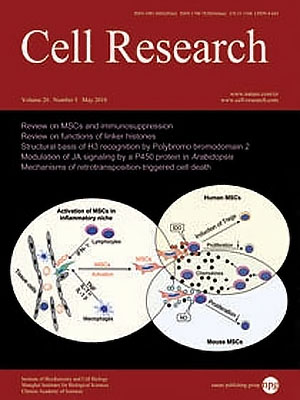
Volume 20, No 5, May 2010
ISSN: 1001-0602
EISSN: 1748-7838 2018
impact factor 17.848*
(Clarivate Analytics, 2019)
Volume 20 Issue 5, May 2010: 510-518
REVIEWS
Mesenchymal stem cells: a new strategy for immunosuppression and tissue repair
Yufang Shi1, Gangzheng Hu1, Juanjuan Su1, Wenzhao Li1, Qing Chen1, Peishun Shou1, Chunliang Xu1, Xiaodong Chen1, Yin Huang1, Zhexin Zhu1, Xin Huang1, Xiaoyan Han1, Ningxia Xie1 and Guangwen Ren2
1Key Laboratory of Stem Cell Biology, Institute of Health Sciences, Shanghai Institutes for Biological Sciences, Chinese Academy of Sciences/Shanghai Jiao Tong University School of Medicine, Shanghai 200025, China
2Department of Molecular Genetics, Microbiology and Immunology, Robert Wood Johnson Medical School-University of Medicine and Dentistry of New Jersey, Piscataway, NJ 08854, USA
Correspondence: Yufang Shi,(shiyufang2@gmail.com)
Mesenchymal stem cells (MSCs) have great potential for treating various diseases, especially those related to tissue damage involving immune reactions. Various studies have demonstrated that MSCs are strongly immunosuppressive in vitro and in vivo. Our recent studies have shown that un-stimulated MSCs are indeed incapable of immunosuppression; they become potently immunosuppressive upon stimulation with the supernatant of activated lymphocytes, or with combinations of IFN-γ with TNF-α, IL-1α or IL-1β. This observation revealed that under certain circumstances, inflammatory cytokines can actually become immunosuppressive. We showed that there is a species variation in the mechanisms of MSC-mediated immunosuppression: immunosuppression by cytokine-primed mouse MSCs is mediated by nitric oxide (NO), whereas immunosuppression by cytokine-primed human MSCs is executed through indoleamine 2, 3-dioxygenase (IDO). Additionally, upon stimulation with the inflammatory cytokines, both mouse and human MSCs secrete several leukocyte chemokines that apparently serve to attract immune cells into the proximity with MSCs, where NO or IDO is predicted to be most active. Therefore, immunosuppression by inflammatory cytokine-stimulated MSCs occurs via the concerted action of chemokines and immune-inhibitory NO or IDO produced by MSCs. Thus, our results provide novel information about the mechanisms of MSC-mediated immunosuppression and for better application of MSCs in treating tissue injuries induced by immune responses.
Cell Research (2010) 20:510-518. doi:10.1038/cr.2010.44; published online 6 April 2010
FULL TEXT | PDF
Browse 2218


